These images do not exist. Everything is made with the midjourney AI and touched up with photoshop and illustrator. All text compiled comes from fever dreams.
Don't wanna be here? Send us removal request.
Text
Slimez Shoes Commercial
youtube
Today, we have another piece of lost media! This week we are showing off a commercial for a popular 90s fashion brand called Slimez. Slimez was a fashion brand that sold light up glow-in-the-dark shoes that used green slime whenever the user was walking around with the shoes on. The shoes proved to be highly popular for children, however, the popularity would come at a cost.
This video is part of an ongoing series that will cover the entire Slimez saga. Stay tuned for the next part in which we take a look at commercials featuring teenage heartthrob Jackson Joe Johnson.
#ai artwork#humor#midjourney#parody#ai generated#joke#fever dream#aiartcommunity#bizarre#ai#Slime#ooze#90s#90s lost media#lost media#Youtube
4 notes
·
View notes
Text
But think of the poor capitalist that need that energy money? How will THEY survive?



Source

12K notes
·
View notes
Text
White Castle's The Big F-ing Crave (90s Lost Media VHS Recording)
Today, we have another piece of lost media! The infamous White Castle's The Big F-ing Crave commercial was shown in only a few times before being pulled off the air. The commercial gained a large amount of media attention due to its using of the f-word (albeit it was censored). The commercial was seen as a bizarre attempt to reach Gen Xer's with its apathetic anti-consumer nature.
youtube
#ai artwork#humor#midjourney#parody#ai generated#joke#fever dream#bizarre#aiartcommunity#ai#90s lost media#lost media#vhs aesthetic#vhs effect#white castle#fast food#giant food#burgers#Youtube
1 note
·
View note
Text
The Numerical Odyssey: A Tale of Counting (Commercial for 1995 Lost Media)
Today, we have another piece of lost media! The Numerical Odyssey: A Tale of Counting was a video series released by PBC (Public Broadcasting Corporation).
youtube
The video series sought to teach children the importance and history of numbers. The series was hosted by esteemed British actor Sir Winston Tallyman. The series chronicled the history, discovery, and invention of numbers. The videos were sold directly to consumers through tv advertisements such as this one. The video series hoped to chronicle every number in existence but unfortunately stopped at 347. The series released its first 12 volumes in a video set for $39.95, with additional volumes being sent by mail for $15.99. The series begin its run in 1995 and ended in 1999.
The series was controversial due to its narrative that numbers were “discovered” or “invented”. Many parents were confused by this and often sought refunds. Parents would become upset upon finding out they could not receive refunds.
#ai artwork#humor#midjourney#parody#fever dream#joke#ai generated#aiartcommunity#bizarre#ai#numbers#90s lost media#lost media#vhs aesthetic#vhs tapes#vcr#vhs art#vhs#90s tv#vintage 90s#90s aesthetic#90s#90s commercials#Youtube
8 notes
·
View notes
Text
FOUND: Wendy's The BIGGIE Cube Commercial (90s Lost Media)
Today, we have another piece of lost media! The infamous Wendy's BIGGIE Cube commercial was shown in only a few times before being pulled off the air. Dave Thomas, the well known spokesman for his restaurant Wendy's, made a strange statement in this commercial, confusing viewers.
youtube
This commercial was found again in a box of VHS tapes that was recorded during another airing of the hit show "Glurm!". The commercial had some minor controversy due to what Son viewers consider to be the bizarre nature of Dave Thomas talking about cubes. This commercial aired not long before Dave Thomas was asked to resign from Wendy's due to his bizarre behavior and costing the company $10 million in lost revenue due to wasted meat.
#ai artwork#humor#midjourney#parody#ai generated#joke#fever dream#aiartcommunity#bizarre#ai#wendy's#dave thomas#cube#cube meat#cubes#all hail the cube#fast food#90s#lost media#90s lost media#Youtube
3 notes
·
View notes
Text
Followup: Burger King DOUBLE TOP Burger Commercial
Get ready for a wild ride as we embark on an epic quest through the lost treasures of 90s media. Today, we're diving headfirst into the captivating tale of Burger King's notorious menu item, the "Double Top Burger." Picture this: it's the fall of 1998, and Burger King unveils this enigmatic creation to the world. But hold on tight, because things are about to get even more bizarre!
During the glory days of the 90s, this curious burger made its appearance on the menus, only to be met with confusion and speculation. And that's not all! Imagine stumbling upon a VHS recording of a commercial that aired exclusively in a handful of test markets. Yeah, it's that kind of hidden gem we're dealing with here!
So, what made this commercial so special? Well, it was featured during an episode of the beloved show "Glurm!"—an absolute must-watch for any 90s fanatic. But this wasn't your run-of-the-mill advertisement. Oh no, it had an air of mystery and perplexity that left viewers scratching their heads. Was it a real product or just an outlandish April Fools' Day prank? The debate was on!
youtube
Now, picture this: a static shot of the Double Top Burger, slowly zooming out. But wait, there's more! A charismatic voiceover guy takes the stage, dropping some mind-bending questions. Brace yourselves, people! He asks, "If there's only top buns, what happens to the bottom buns? Without a bottom, does that mean there is no hell? If there is no hell, does that mean there is no heaven?" Talk about a thought-provoking twist!
But alas, despite the initial intrigue, the Double Top Burger fell flat on its face. The quirky commercial with its philosophical musings didn't quite hit the mark with consumers. And let's be real, folks, removing the bottom bun threw everyone off their game. It's like messing with the sacred burger-eating rituals we all know and love. Needless to say, the Double Top Burger became a cautionary tale of marketing gone astray.
As we reflect on this incredible journey through 90s nostalgia, we're reminded of the fascinating stories that lie within the lost media of yesteryear. The Double Top Burger's rise and fall serves as a reminder of the delicate balance between innovation and meeting consumer expectations.
#ai artwork#humor#midjourney#parody#fever dream#ai generated#aiartcommunity#joke#bizarre#ai#burger king#90s#lost media#Youtube
4 notes
·
View notes
Text
Are You My Daughter? The Wacky Paternity Game Show

In 1997, Fox TV launched a revolutionary new game show called "Are You My Daughter?" Hosted by Edward Osscifer, a famous spokesperson for the bacon substitute product liquid bacon, the show was created to provide cheap content that could be made and marketed quickly. Osscifer was chosen because of his rise in popularity after apologizing for lying about being a star on the hit TV show "Glurm."





(Scenes From Episode 1)
The game show was a bizarre combination of a dating game and a paternity test show. Three men with dementia were brought onto the show, each with the possibility of being the father of a young woman. The men were asked a series of questions about their potential daughter, and every time they answered incorrectly, a loud buzzer would blare over their heads. The crowd was encouraged to yell "not the father" every time a contestant got an answer wrong. If the "daughter" felt she had found her father, she could hit a giant red button to end the questioning round. The men would then be given a paternity test to determine if they were the father of the "daughter."





(Scenes From Episode 2)
Although the show was a ratings success, it was soon plagued by controversy. Critics objected to the use of men with dementia, arguing that they were being exploited for entertainment. Others pointed out that the "daughters" were all actresses and not related to the contestants in any way, making the show a complete farce.



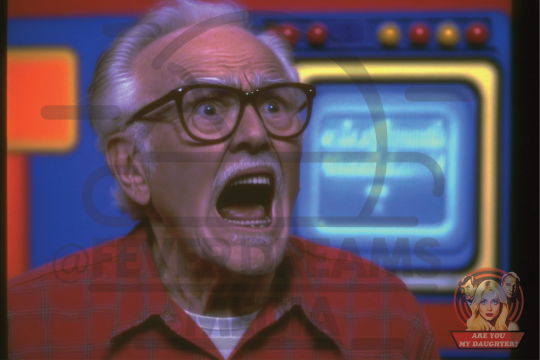

(Scenes From Episode 3)
The use of blonde women also drew criticism from feminist groups, who argued that they were being used as mere props on the show. Women's groups also objected to Osscifer's inappropriate comments toward the contestants, particularly his remarks about their appearance.

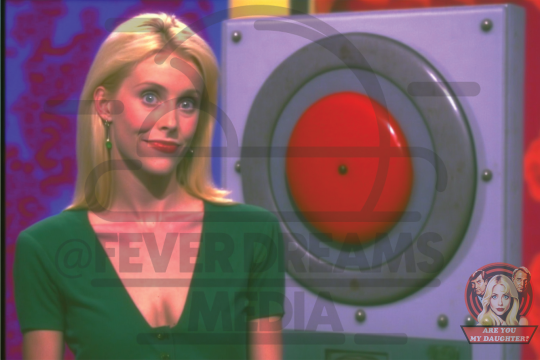



(Scenes From Episode 4)
The show was canceled after its fifth episode, during which it was revealed that Osscifer was the father of one of the "daughters." His stunned face was seen by an audience of 15 million viewers, and Osscifer retired from acting shortly after the show was canceled.





(Scenes From Episode 5)
“Are You My Daughter?" proved to be a bizarre and controversial experiment in game show history. While it was certainly unique, it was also deeply flawed and ultimately failed to resonate with audiences. Perhaps it was a cautionary tale about the dangers of pursuing cheap and easy entertainment at any cost.
#ai artwork#humor#midjourney#parody#ai generated#joke#fever dream#aiartcommunity#bizarre#ai#dating game#90s asthetic#90s tv#90s style#90s pop culture#90s nostalgia#90s vibes
5 notes
·
View notes
Text
The McTaco Fiasco: The Failed McDonalds Item That Sparked Controversy

In the late 90s, McDonalds attempted to bring out a new breakfast item with the McTaco. The company had high hopes for this new menu item, and even rolled out a new ad campaign with a character named Ronaldo McDonaldo, who was portrayed as Ronald's cousin from Mexico. The advertisements promised a taste of authentic Mexican breakfast and even offered a collector's cup with a mustache and sombrero.
However, the McTaco failed to gain national release and was only available in test markets. This was due to the negative attention that Ronaldo McDonaldo drew for its portrayal of Hispanic people. Many people felt that the character was stereotypical and offensive, and the controversy surrounding it was enough to keep the McTaco from being rolled out nationwide.
One of the ads depicted Ronaldo McDonaldo as the bringer of an "authentic" Mexican breakfast, with the tagline "Say Hola to Breakfast!" The ad promised a tasty breakfast of creamy scrambled eggs, spicy chorizo sausage, and melted queso sauce, topped off with a signature mustache and sombrero cup.

Another ad showed Ronaldo McDonaldo saying "Arriba! Ronaldo McDonaldo here (Ronald's cousin) and I've just come back from Mexico with something new for all you niños and niñas!" He boasted about his new McTacos and even offered a collector's cup for only $1.99.

There were even plans to roll out a breakfast happy meal with the McTaco, as well as a happy meal toy mustache. However, these plans fell through when the nationwide rollout didn't occur.


The McTaco was a failed attempt by McDonalds to bring out a new breakfast item. The ad campaign featuring Ronaldo McDonaldo sparked controversy for its portrayal of Hispanic people and the McTaco was only available in test markets. The McTaco remains a cautionary tale for companies who want to market new items to diverse groups of people.

#ai artwork#humor#midjourney#parody#ai generated#joke#fever dream#aiartcommunity#bizarre#ai#mcdonald’s#taco#tacos#mctacos#ronald mcdonald#i’m loving it#did somebody say McDonald’s#taco Tuesday
13 notes
·
View notes
Text
"First Down Defense": A look at the first script.
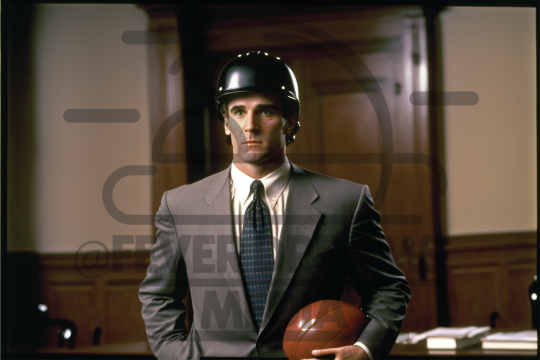
To follow up our last post looking back at “First Down Defense”, here is an exclusive look at the script used in the pilot episode! The pilot episode was filmed in the beginning of 1996.

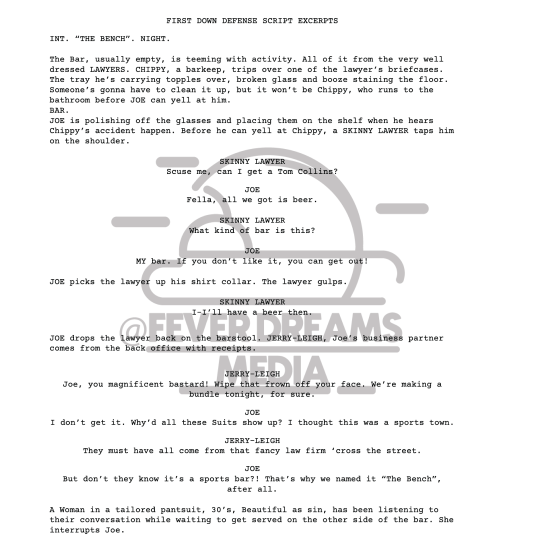

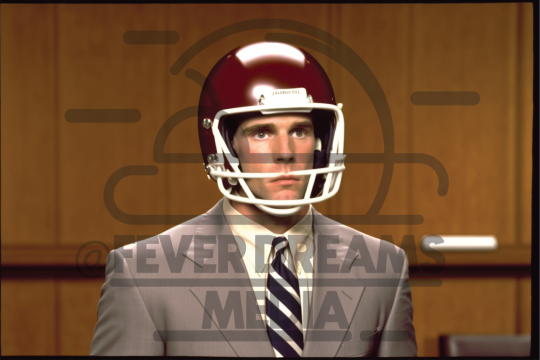




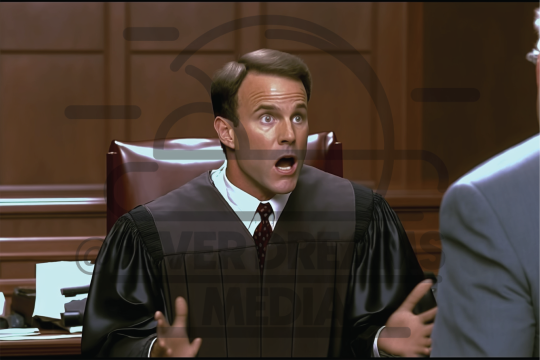
"Joe, you can't tackle opposing counsel! I'm surprised that Judge Fortissimo even allowed you to come back for closing arguments."

"Boys, I need to call in a favor. Can you put on your best suits?"
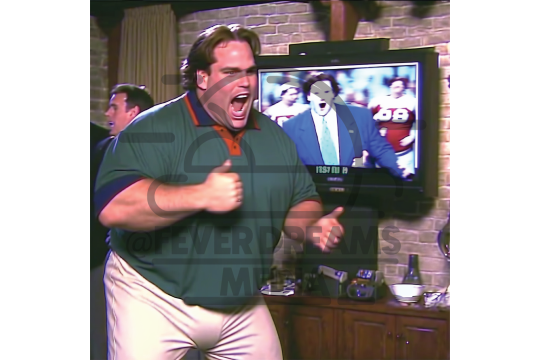

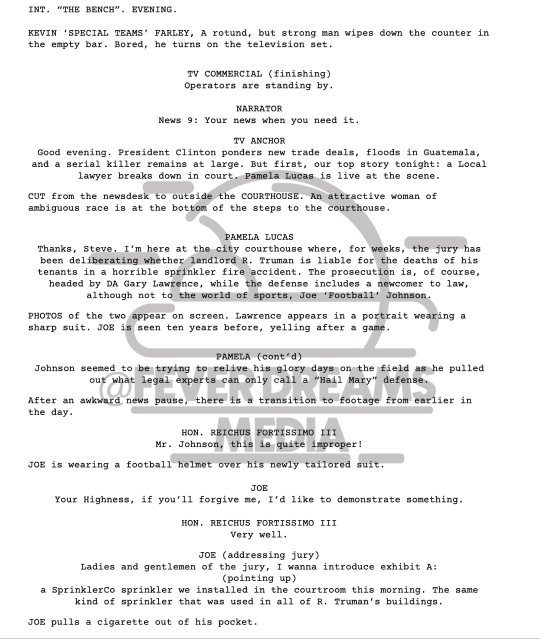


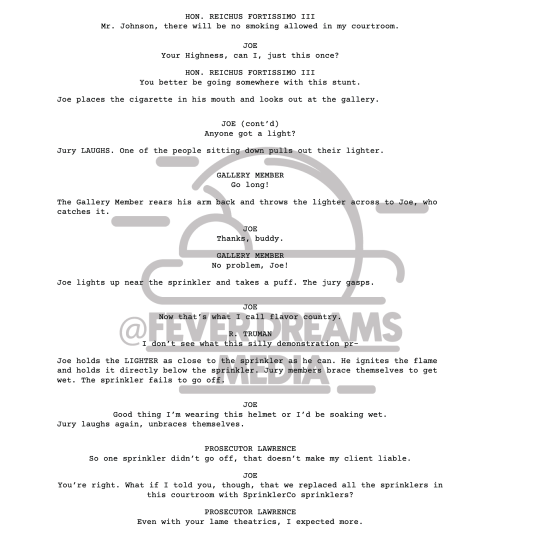

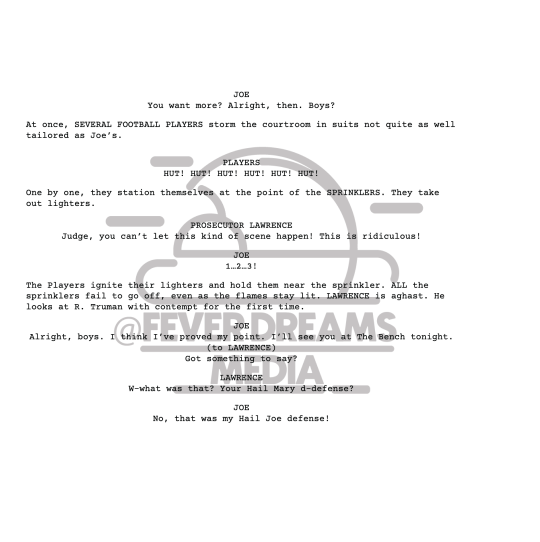
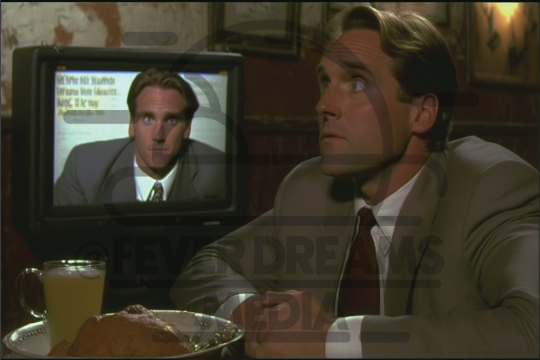
"All in a days work."
#ai artwork#humor#midjourney#parody#ai generated#joke#bizarre#fever dream#ai#aiartcommunity#football#lawyers#script#David E. Kelly#90s pop culture#90s asthetic#90s vibes#90s tv
2 notes
·
View notes
Text
"First Down Defense": A Unique Legal Drama-Comedy

When it comes to legal dramas, "First Down Defense" was like no other. Premiering in the fall of 1996 on ABC, the show followed Joe "Football" Johnson, a former football player turned bar owner turned lawyer. With a cast of quirky characters, this show had all the elements of a hit comedy-drama, but unfortunately, it failed to maintain its popularity and was canceled in the spring of 1997 after only 12 episodes. The story revolves around Joe, who after suffering a career-ending head injury, opens a sports bar called "The Bench". One day, a lawyer named Tabitha Lingus walks into the bar, causing confusion among Joe and his friends. When he tries to ask her out on a date, he misunderstands her response and believes she only dates lawyers. This leads Joe to become a lawyer, along with his teammates, in order to win Tabitha's heart.


The law offices of "Football, Football, & Football" is unlike any other law firm. The team, consisting of Kip "Kicker" Andrews, Michael “Defense” De Sota, and Kevin “Special Teams” Farley, brings a unique approach to the practice of law by using football terms to describe their legal strategies and making all lawyers and clients wear football helmets. This added a comical twist to the show, making it stand out from other legal dramas.


However, the show also faced criticism for its depiction of head injuries. Joe's character experiences hallucinations in the courtroom, which added a dramatic element to the show, but also brought attention to the issue of head injuries in football. This depiction may have contributed to the show's decline in viewership and ultimate cancellation.
Despite its short-lived run, "First Down Defense" remains a unique and memorable legal drama-comedy. The show's unique approach, quirky characters, and comical elements made it stand out from other legal dramas of its time. Although it may not have been a ratings success, it will always be remembered by those who were able to enjoy its 12 episodes. Stay tuned for the second part which will give you a look at the pilot script and images from the first episode!
#ai generated#ai artwork#aiartcommunity#midjourney#midjourneyart#midjourneyartwork#fever dream#aiartengagement#ai art generation#joke#humor#football#lawyers#drama#tv shows#david e. kelley#90s pop culture#90s style#vintage#90s vibes#vintage 90s#parody
3 notes
·
View notes
Text
Swinging into Action: A Look Back at the 1997 Arcade Game "Nun-Chucks"

In 1997, Japanese gaming company NAMGA released "Nun-Chucks", a light gun style arcade game that allowed players to use a nunchuck controller to play. This was a revolutionary step in the gaming industry as it set itself apart from other arcade shooters by replacing the light gun with a set of nunchucks. The game would require players to swing their nunchucks at the screen in order to defeat their enemies and reload the nunchucks by swinging them off screen.

The reason for NAMGA's creation of "Nun-Chucks" was due to the "Nun Craze" of the 90s, which was sparked by the success of Steeple Fighter, the Vatican approved 2D fighter game. Unlike Steeple Fighter, "Nun-Chucks" did not seek the approval of the Vatican in order to portray the nuns in a more attractive appearance.

Some arcade cabinets even came with a ruler controller option for second player action, which added to the game's uniqueness. "Nun-Chucks" was NAMGA's first 3D arcade game and it was wildly popular in Japan and the United States. However, parents were concerned about the dangers of swinging nunchucks off the screen in order to reload, as several people were injured as a result. The game also required players to swing the nunchuck on the screen, which resulted in several injuries. Despite this, the game was a massive hit in arcades.

Parent group SADMOMANDDAD also felt it was inappropriate to market a game with sexually attractive nuns. Plans were made to make a sequel to "Nun-Chucks", but NAMGA went bankrupt and closed its doors in 1999 due to the failure of the home console game "Glurm's 3D Quest". "Nun-Chucks" will always be remembered as a revolutionary game that pushed boundaries and tested new motion technology, but also as a game that sparked controversy and caused injuries.




#ai generated#ai artwork#midjourney#humor#parody#fever dream#joke#bizarre#warrior nuns#nunchucks#video games#fighting#arcade#nuns
4 notes
·
View notes
Text
Liquid Bacon: The Weird Pourable Bacon
In 1995, a new and unique product hit supermarket shelves across the United States – Liquid Bacon. This bacon substitute was unlike anything else on the market, as it contained no pork or meat products to obtain the bacon flavor. Instead, the company behind the product, Locter & Gramble, referred to their secret recipe as a "trade secret".
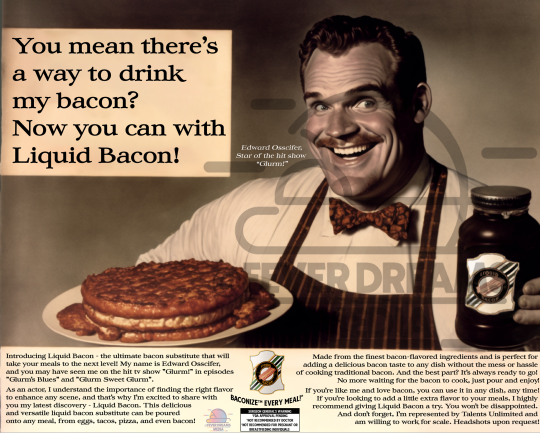
Liquid Bacon was marketed by spokesman Edward Osscifer, who claimed to be a star on the hit show "Glurm!". However, it was later discovered that he had lied on his resume and was actually just a background performer. In advertisements, Osscifer had to apologize for his deception and assure consumers that the product was still worth trying.
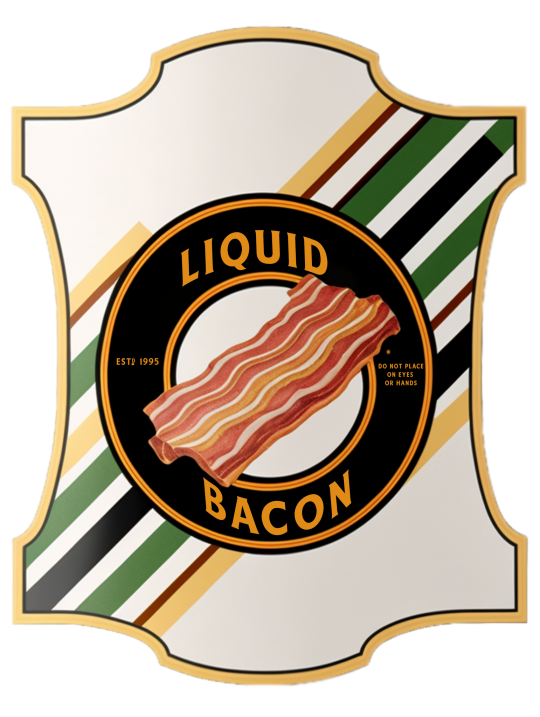
The product came in three flavors – original, black label, and white label. The slogan for Liquid Bacon was "Bacon you can drink" (with an asterisk warning that FDA approval was pending and that it was not recommended by doctors or for pregnant or breastfeeding individuals). However, despite the catchy slogan, many consumers were hesitant to try the product due to concerns about its health and safety.
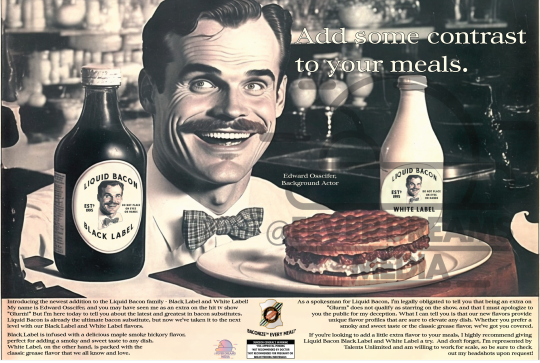
In an attempt to attract more customers, the company planned to release a version of the product specifically for women, called Liquid Bacon Pink. However, this version never made it to market after several women became sick with jaundice after using the product.
Labels for Liquid Bacon were legally required to state that the product should not be placed on the eyes or hands, leading some consumers to fear the health and safety of the product. As a result, sales of Liquid Bacon began to decline and the product was eventually discontinued in the United States.
However, Liquid Bacon can still be found in countries like Mexico, where it is marketed as Tocineta Aqua. While it may have been a unique and intriguing product, the safety concerns and lack of FDA approval ultimately led to its downfall.
#ai artwork#humor#midjourney#parody#ai generated#joke#ai#aiartcommunity#bizarre#baconbaconbacon#mistaken bacon#bacon and eggs
6 notes
·
View notes
Text
Slimez: The Shoes Too Radioactive For Kids

In the early 90s, a new shoe sensation swept through the playgrounds and malls of America. "Slimez", produced by the company KoolKikz, were a hit among kids and teenagers, who loved the bright neon green color and the slime that seeped out of the shoes when they walked. The shoes were heavily advertised by a teenage heartthrob, Jackson Joe Johnson, who was the face of the brand and pushed the shoes as the must-have accessory of the year.



Following the success of the first commercial, and first quarter sales, the company decided that a spokesman was needed to drive sales for the holiday season. They decided upon using teenage heartthrob Jackson Joe Johnson, also known as Triple J or JJJ. Jackson was picked in part due to his popularity on the hit TV show “Glurm!” and for the hit song of the summer “Denim Lover”. The ad campaign featuring Jackson was an immediate success and focused on Jackson telling kids they were not cool if they didn’t buy the shoes.

However, behind the fun and flashy exterior of the Slimez, a dark secret lurked. The slime that seeped out of the shoes was radioactive waste, a fact that KoolKikz tried to cover up and deny. As a result, children and teens who wore the shoes were at risk of radiation poisoning, and many of them suffered serious health problems as a result of their exposure. Jackson himself did an ad where he told child lawsuits weren’t cool. The ad was deemed as questionable but sales continued to skyrocket.

When the FDA and Department of Defense got involved in investigating the shoes the company was unable to hide the truth anymore. Worst of all, it was reported that teenage heartthrob, Jackson Joe Johnson, had died due to radiation poisoning caused by the shoes. He had reportedly been experiencing symptoms associated with radiation poisoning for some time before his passing, and despite receiving medical attention, was unable to recover.

Faced with mounting evidence of the danger posed by the shoes and growing public pressure, KoolKikz was eventually forced to recall the Slimez and offer refunds to customers. The company issued a public apology for the harm caused by their product, but the damage had already been done. The Slimez, and the company behind them, became a cautionary tale of the dangers of putting profit over safety, and the tragic consequences that can result from such negligence.

The incident was a wakeup call for many people, a reminder that even the most fun and trendy products can have serious consequences if they are not properly tested and regulated.
It is a reminder to be always mindful of the safety of the products we consume and to always do the necessary research.
#ai generated#ai artwork#midjourney#humor#parody#fever dream#joke#bizarre#shoes#slime#light up shoes#90s fashion#90s style#90s pop culture
5 notes
·
View notes
Text

Fast Food Failures: A “whopper” of a problem
Burger King's "The Double Top" was a unique burger that was introduced in 1998. The burger featured two top buns, making it different from any other burger on the market at the time. However, the burger was not a success and was quickly pulled from the menu.
The reason for the creation of the "The Double Top" was due to a mistake in Burger King's supply chain management. The company had ordered too many top buns, and they needed to find a way to use them up. The solution was to create a burger with two top buns.
Unfortunately, the burger was a failure for a number of reasons. One of the main reasons was that people didn't understand how to eat the burger. Without a bottom bun, the burger was difficult to hold and eat. Additionally, the marketing campaign for the burger was criticized for its bizarre tone. The ads portrayed the burger as "sinful" and were supposed to be humorous, but they sparked complaints from parent groups and were seen as inappropriate for children.
Overall, the "The Double Top" burger was a failure for Burger King. The mistake in supply chain management and the bizarre marketing campaign ultimately led to the burger's demise. It serves as a reminder of the importance of proper supply chain management and the potential consequences of a poorly executed marketing campaign.
6 notes
·
View notes
Text

Fast Food Failures: The Time of the Giant Burgers
White Castle wanted to compete with Wendy's Biggie Cube and spent $15 million dollars and two years trying to perfect a giant slider that could retain its shape and be cooked correctly without giving its customers food poisoning. They were able to succeed in their endeavor but they missed the boat on it and were too late. However, with over 15 metric tons of ground beef sitting in warehouses on the East cost they needed to sell burgers and fast.
White Castle figured why not get a sports endorsement. They assumed it would be easy enough.
It was not.
The only one who said yes is Jesús "Digits" Gonzalez, the six fingered relief pitcher for the New York Mets. Jesús was paid $10 million dollars for his endorsement. With this money Jesús was finally able to afford surgery to remove the extra digits on his hands.
White Castle’s marketing team dubbed the new creation “The Big Fucking Crave” as a way of attracting as much attention as possible. White Castle lost over $25 million dollars in wasted ground beef as no one was willing to eat the giant slider.
#ai#ai artwork#aiartcommunity#ai generated#midjourneyartwork#midjourneyart#midjourney#Midjourneyai#joke#humor#meat cube#fresh meat#white castle#fast food#parody#slider#giant burgers
3 notes
·
View notes
Text


Fast Food Failures: The Time of the Giant Burgers
It may come as a total surprise but sometimes a fast food restaurant will release a product that fails so poorly that it almost causes a company to fail. Here is an example of to companies and their literal massive food failures.
The BIGGIE Cube was an attempt by Wendy’s to gain a bigger market share by offering customers more meat than their competitors. The resulting product simply name “The Biggie Cube” was considered a total failure as Wendy’s was losing over $10 million dollars shipping fresh ground beef to stores every month. Founder Dave Thomas famously stated he would stand behind the product even at a loss because if it meant he would be offering customer the best old fashioned hamburgers in the business then he didn’t care about going out of business. He was even seen holding raw meat and making surprise visits to franchises to get more customers to try the giant meat cube. Dave Thomas was asked to retire shortly after shareholders approved a forced retirement for the founder.
#aiartcommunity#ai artwork#ai#midjourney#midjourneyart#midjourneyartwork#burger#fast food#parody#humor#raw meat#cube#fresh meat#meat cube#wendy’s
1 note
·
View note